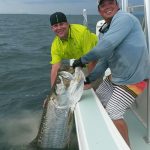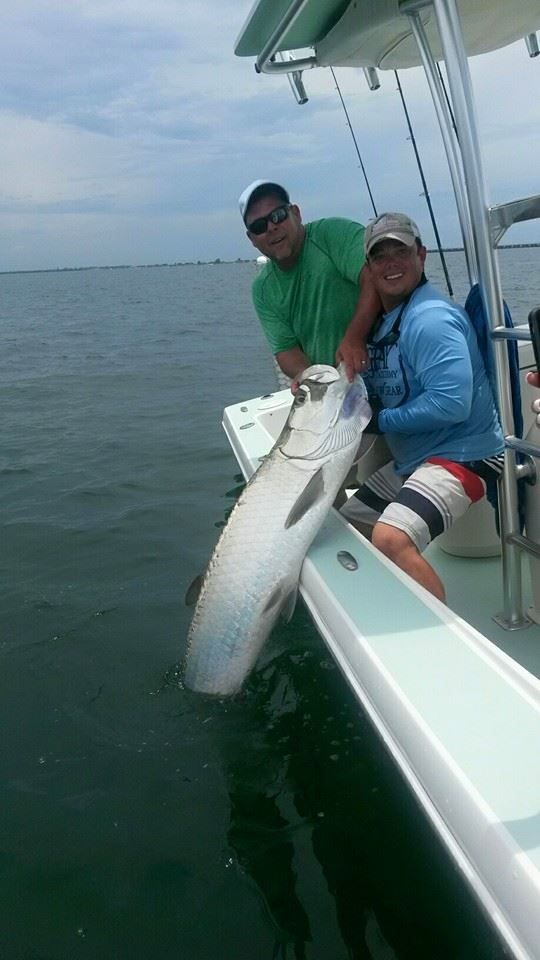 April will mark the beginning of our tarpon season. Consistent reports of poon sightings and hookups start to spread quickly, and everyone starts to feel symptoms of tarpon fever. You know tarpon fever is spreading when tackle shops start to run out of heavier Fluorocarbon leader, bigger circle hooks are disappearing of the racks, and guys are flooding in one after another with big dusty spinning reels to get them reloaded with heavier braid. Other symptoms of tarpon fever include: buying big heavy cast nets, practicing your Bimini twist, arguing with other fisherman about the best tarpon tackle, guys sharing their “Top Secret” tarpon techniques with anyone who will listen, and people asking where they can find those cute little crabs.
April will mark the beginning of our tarpon season. Consistent reports of poon sightings and hookups start to spread quickly, and everyone starts to feel symptoms of tarpon fever. You know tarpon fever is spreading when tackle shops start to run out of heavier Fluorocarbon leader, bigger circle hooks are disappearing of the racks, and guys are flooding in one after another with big dusty spinning reels to get them reloaded with heavier braid. Other symptoms of tarpon fever include: buying big heavy cast nets, practicing your Bimini twist, arguing with other fisherman about the best tarpon tackle, guys sharing their “Top Secret” tarpon techniques with anyone who will listen, and people asking where they can find those cute little crabs.
Tampa Bay tarpon come from near and far to do two of my favorite things, eat and make love! They follow the big herring and sardine schools onto the beaches and into the bay and feed voraciously in between offshore spawning sessions. This is the time of year I get geared up and ready for tarpon fishing to break loose. When putting together tarpon tackle the most important things to consider are where you will be fishing and what kind of bait you will be using. As far as rods and reels go, I recommend a long stout rod with a softer tip and well-built spinning reel with plenty of drag. Having a few rods in the 7-8 ft., 15-50 lb. class rating is a good idea. Two of my favorites are the Shimano Teramar 8 ft. 15-40 and the Crowder E-Series 8ft. 20-40 for the big boys around the bridge. As far as spinning reels go, depending on how well it’s built and line capacity, a quality reel in the 6000 to 12000 range will do fine. This is one of those times where spending a few extra bucks on a higher end reel will pay off on the water. My go to all around tarpon reel is a Fin-Nor OFS 5500. Tarpon have a reputation for blowing up less expensive reels and destroying inadequate drag systems in a matter of minutes. You want to look for a reel with 20-40 pounds of drag for when you really need to put the pressure on them.

When it comes to rigging my rods, I like to fill them with 50lb. braid and always tie a Bimini Twist before my leader. Tying a Bimini in braid has many benefits. Tied right it will offer a little bit of shock absorption to your connection which is important since braid has nearly zero stretch. It also allows for stronger braid to leader connection and offers a few extra feet of doubled line for rubbing against any structure. More than once has a tarpon rubbed my line against a piece of structure and frayed or broke one of the strands in the bimini while the other held up through the remainder of the fight. When it comes to leader selection, two factors to consider are water clarity and braid strength, but fluorocarbon is a must in my opinion. I do not like using a leader with a lesser breaking strength than my braid if at all possible and the only time I will is when I feel that the tarpon are being overly leader shy. I like to use 40-60 lb. on the beaches and 60-80 lb. around the bridges when you have to work them around the pilings.
When it comes to keeping those tarpon “glued” and on your line, choosing the right hook can make all the difference. I prefer circle hooks between 4/0-8/0 depending on the size and type of the bait being used. In my opinion circle hooks are far superior to J hooks when it comes to not only hooking tarpon in the right areas of their mouth, but keeping them on the through the duration of the fight.
My favorite all-purpose tarpon rig consists of a spool full of 50lb. Momoi Diamond Braid finished with a Bimini Twist to a Double Uni to 8 ft. of 60 lb. Seaguar fluorocarbon leader and 7/0 Owner Mutu circle hook.
When it comes to bait, the key is to figure out what they are eating and have plenty of it. Often times it’s live sardines or big threadfin herring, but sometimes they want to eat pass crabs and only pass crabs. When baiting up for the day and you’re not sure exactly what they are in the mood for, try to get a little bit of everything. By putting a few different kinds of baits out at once, this will allow the tarpon to swim down your buffet line and tell you exactly what they are in the mood for. Don’t overlook dead bait either. Tarpon are not exactly the apex predators that many people think they are, in fact I think they are much more scavenger than predator. Fishing dead bait around the bridges and even off the beaches can prove very successful.
Remember to stop by your local tackle shop and pick up a few tagging kits. They are readily available up and down the west coast and are a great way to not only keep track of your catches, but help improve tarpon study and research.
Being effective at both hooking tarpon and getting them boatside takes not only practice and skill, but good preparation. Take some time before you hit that water in search of the silver king to make sure your tackle is set up correctly and you have a solid game plan!
Captain Matt can be reached at 813-205-2327, online at www.FishingGuideTampa.com, on twitter at @captainmatts or at Facebook.com/Fishwithcaptainmatt
